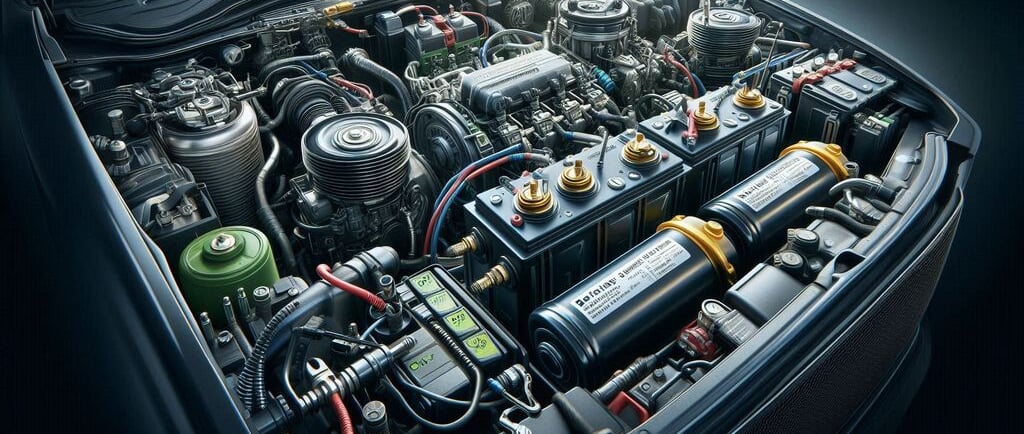Batteries: Powers the electrical system and starts the engine.
Imagine being ready to drive your car, only to discover it won’t start. A dead battery is one of the most common reasons this happens.
LIGHTING AND ELECTRICAL PARTS
11/12/20244 min read


Batteries: Powers the Electrical System and Starts the Engine
Imagine being ready to drive your car, only to discover it won’t start. A dead battery is one of the most common reasons this happens. Batteries play a crucial role in powering your vehicle’s electrical system and starting the engine. Without a properly functioning battery, your car simply won’t run.
In this article, we will explore the essential role of car batteries, their different types, how to maintain them, and some helpful tips to ensure they last as long as possible. Whether you're a first-time car owner or a seasoned driver, understanding the importance of your vehicle’s battery can save you time, money, and frustration.
Why Batteries Are Essential for Your Car
1. Starting the Engine
The most important function of a battery in your vehicle is starting the engine. When you turn the key or press the start button, the battery sends an electrical charge to the starter motor. This action initiates the combustion process, allowing the engine to run.
Key role in ignition: Without a charged battery, the starter motor wouldn’t have the power to turn the engine over.
Engine's spark: The battery also powers the spark plugs that ignite the air-fuel mixture in your engine, ensuring it runs smoothly.
2. Powering the Electrical System
Once the engine starts, your car's battery continues to support the electrical system. It powers essential components like lights, air conditioning, radio, and even your car’s advanced electronics, including navigation and entertainment systems.
Reliable power: Your battery ensures that all electronic systems in your car receive steady power, even when the engine is idling or not running at high speeds.
Continual charging: The alternator works with the battery to recharge it while the engine is running, keeping the electrical system powered throughout your drive.
Types of Car Batteries
1. Lead-Acid Batteries
Lead-acid batteries are the most common type found in vehicles. They are relatively inexpensive and reliable, providing the necessary power to start the engine and run electrical components.
Durability: Lead-acid batteries typically last between 3 to 5 years, depending on driving conditions and maintenance.
Maintenance: These batteries require little upkeep but may need periodic checking for fluid levels.
2. Absorbent Glass Mat (AGM) Batteries
AGM batteries are a more advanced type of lead-acid battery, offering better performance and reliability, especially in vehicles with more demanding electrical needs, like luxury cars or trucks.
Improved power: AGM batteries offer more power and are less prone to leaks and damage.
Longer lifespan: These batteries can last up to 7 years, depending on conditions.
3. Lithium-Ion Batteries
While not yet as widespread in traditional vehicles, lithium-ion batteries are becoming more popular in electric and hybrid cars. They offer superior power output and a longer lifespan.
Lightweight and efficient: These batteries are much lighter and can provide more consistent power for extended periods.
Long-term investment: Though they are more expensive, lithium-ion batteries can last up to 10 years or more.
Signs Your Car Battery May Be Failing
1. Slow Engine Crank
One of the first signs that your battery is losing charge is a slower-than-normal engine start. If your car takes longer than usual to start, it could be a sign that the battery is weakening.
What to watch for: A slow crank is often accompanied by dimmed headlights or other electrical issues when you turn on the car.
2. Warning Lights
Most modern vehicles come equipped with battery warning lights that alert you when the battery or charging system is having issues. These lights can indicate a variety of problems, such as a failing battery or a faulty alternator.
Immediate attention required: If the battery light appears, it’s important to check the battery as soon as possible to prevent being stranded.
3. Electrical Failures
If your electrical components are not working properly, such as flickering headlights or malfunctioning dashboard electronics, it could be a sign of a weak battery.
Non-starting vehicle: In extreme cases, a completely dead battery will cause the car to fail to start altogether.
How to Maintain Your Car Battery
1. Regular Inspection
Check your battery regularly for any signs of corrosion, leaks, or loose connections. Corrosion can build up around the battery terminals, which can impact its performance and cause starting issues.
Clean the terminals: Use a mixture of baking soda and water to clean the terminals and prevent corrosion buildup.
2. Keep the Battery Charged
If you don't drive your car often, consider using a battery charger or maintainer to keep the battery at an optimal charge level. A battery that isn’t regularly charged may lose its ability to start the engine.
Charge when needed: This is especially important for people who drive infrequently or store their vehicles for long periods.
3. Monitor Battery Age
Car batteries don't last forever. If your battery is over 3 years old, it’s a good idea to have it tested regularly at an auto shop to ensure it’s still in good condition.
Replace before failure: Replacing your battery before it fails can prevent inconvenient breakdowns and save money in the long run.
How to Extend the Life of Your Car Battery
1. Turn Off Electronics When Not in Use
Avoid keeping electronics running when the engine is off, such as the radio or lights. These can drain the battery, especially if you’re parked for a long time.
Energy-saving habits: Try to develop the habit of turning off any unnecessary electrical systems before turning off the engine.
2. Avoid Short Trips
Frequent short trips can prevent the battery from fully charging. Try to drive longer distances to ensure the alternator has enough time to recharge the battery properly.
Regular drives: Long, uninterrupted trips allow the battery to maintain its charge and keep the system running optimally.
Conclusion: Keep Your Battery in Top Shape
Your car’s battery is the heart of its electrical system, providing the power needed to start the engine and operate all essential electronics. By understanding the role of your battery, maintaining it regularly, and knowing when it’s time to replace it, you can keep your car running smoothly and avoid unexpected breakdowns.



